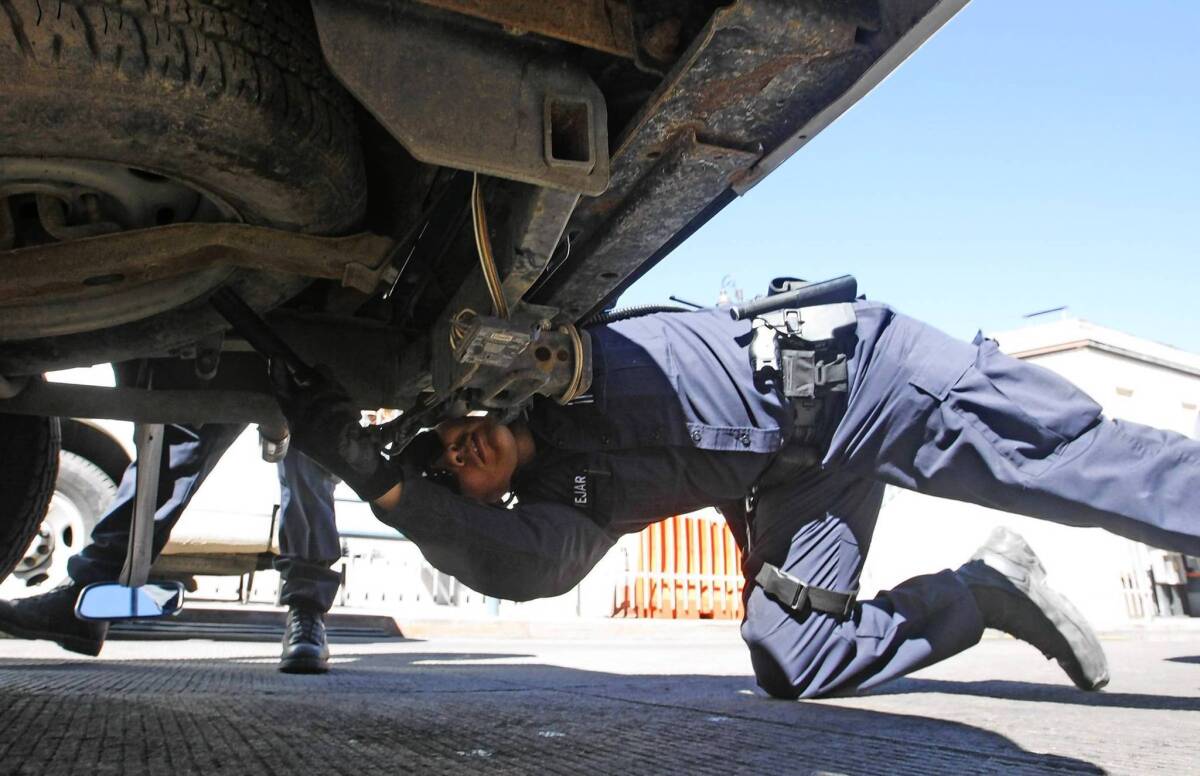Gun smuggling to Mexico dented, but hardly slowed, by border searches

NOGALES, Ariz. — Gun runners once were so nonchalant about driving into Mexico that one smuggler stashed a .50-caliber rifle on the top of the engine block of a sedan, the weapon visible to anyone who bothered to pop the hood.
It was 2010 and word hadn’t yet spread that U.S. officials were beefing up outbound inspections, searching for guns that were fueling Mexico’s raging drug war. Border agents confiscated the rifle and hundreds of other weapons and ammunition during the first few years of stepped-up enforcement along the southwestern border, federal data show.
Mexican officials have also taken action, installing scales to see whether southbound cars are abnormally overweight — a possible indication of gun smuggling.
But as inspections have become more aggressive, smugglers have become more sophisticated.
Instead of sending a big shipment of AK-47s in one vehicle, U.S. officials said, arms traffickers dismantle weapons and transport the pieces in separate vehicles. A bolt carrier here. A flash hider there.
Smugglers have also used drivers who theoretically would avoid suspicion. Agents once recovered ammunition in the molding of a minivan. The vehicle was driven by a father. Mom sat beside him, with kids in the back.
In December, one smuggler trying to pass through the San Luis port of entry in western Arizona concealed ammunition magazines in the rear seat, door panels and rear bumper of a 1991 Oldsmobile Cutlass.
Jose Angel Palacios pleaded guilty in May to smuggling 60 magazines that could be used with AK-47s, a weapon of choice for drug cartel enforcers. Palacios, 20, a Mexican national, told authorities he had been promised $150 to make the delivery.
At least 2 of every 3 firearms confiscated in Mexico from 2007 to 2011 were purchased in the United States and smuggled south, according to the Bureau of Alcohol, Tobacco, Firearms and Explosives. Many of the weapons ended up in the hands of criminal organizations and were used against the military, journalists and civilians.
“In the last six years, they had over 70,000 people murdered in drug-related violence, and a vast majority were using very sophisticated firearms that came from the United States,” said Eric Olson, associate director of the Latin American Program at the Woodrow Wilson International Center in Washington. “It’s having a dramatic impact on Mexico.”
Experts and scholars say the problem is due largely to laws that make it difficult to prosecute gun trafficking, especially by straw buyers — people who can pass background checks and purchase guns only to turn them over to drug cartels.
Recently, proposals intended to curtail gun trafficking died in Congress. The legislation faced stiff opposition by some gun rights groups, such as the National Rifle Assn.’s lobbying arm.
“I think the 2nd Amendment is being scapegoated for a problem that is rooted in Mexico,” said Andrew Arulanandam, spokesman for the NRA Institute for Legislative Action. “There is pervasive corruption within the ranks of government, military, law enforcement and judiciary. That’s the root of the problem.”
Mexican officials did not provide comment on the issue despite repeated inquires.
The NRA took issue with the ATF data on gun smuggling, describing the agency’s findings as incomplete because they relied on Mexican officials, who the NRA says are likely to report guns only from the U.S.
“You are talking about multimillion-dollar criminal enterprises that have sophisticated armored cars,” Arulanandam said. “The very premise that these drug cartels are buying their firearms one firearm at a time from a gun show in Arizona or Texas is ludicrous.”
Still, that is what’s happening, contended Olson, who leads a group of researchers who study gun trafficking.
In a report, Olson’s group argued that prosecuting gun trafficking is difficult because of weak or imprecise laws. Straw purchasing is not a felony under federal law. If convicted, a straw purchaser may simply have to pay a fine of a few hundred dollars for what amounts to lying on a form.
In Arizona, going after straw buyers has proved frustrating, said former Arizona Atty. Gen. Terry Goddard.
He recalls how state prosecutors in 2008 accused the owner of X Caliber Guns, a gun shop in a Phoenix suburb, of arming Mexican cartels. A judge dismissed the case, stating there wasn’t enough proof, based on the state law’s limited definition of straw purchasing.
Goddard lobbied the U.S. attorney’s office in Phoenix to take up the case. “I can tell you that I went to the top, and they apparently decided not to do it,” he said.
Ultimately, Goddard’s office stopped prosecuting straw purchasing cases. In the X Caliber Guns case, he said, the state had to return nearly 1,000 guns to buyers, and the company is still in business.
The troubled Fast and Furious gun tracking operation helps illustrate the problem, experts said. The federal program allowed weapons to be illegally sold in the U.S. so they could later be tracked across the border to drug cartels. But most of the firearms disappeared, and at least one was found at the scene of the slaying of a Border Patrol agent in Arizona in 2010.
Although the botched operation led to an outcry in Congress, it revealed the extent of gun trafficking networks and the role of straw buyers, Olson said.
A rise in drug violence related to gun trafficking about five years ago prompted Homeland Security Secretary Janet Napolitano to announce a greater focus on outbound inspections along the southwestern border.
At the DeConcini port of entry in Nogales, outbound inspections before 2009 were irregular, said Guadalupe Ramirez, port director for U.S. Customs and Border Protection there. Now, two lanes are dedicated to outbound inspections, fully staffed 24 hours a day. Agents make a couple of seizures a week — weapons, ammunition, cash or other illicit cargo.
Since 2009, agents have seized 153 weapons at Arizona’s border crossings.
Weapon seizures tapered off when cartel leaders caught on. So far this fiscal year, agents have recovered 18,015 rounds of ammunition and 63 firearms at ports along the southwestern border from California to Texas.
Officials have augmented the ports with new technology, such as license plate readers installed a few months ago in Nogales to flag stolen or wanted vehicles. They’ve also teamed up with Border Patrol agents and local authorities who send staff to help with inspections. But outbound inspections will never be as robust as the inbound ones, Ramirez said.
“You have to remember that the reason why we focus on inbound is because our job is to identify threats coming into the United States,” he said. “That’s our primary mission — terrorists, narcotics, illegal aliens.”
Still, southbound traffic is getting more scrutiny than ever before.
One winter day, a customs agent stopped a car for a secondary inspection and escorted an elderly Mexican driver to a room for further questioning as second agent tapped the guts of the man’s sedan with a metal pole. If it sounded like concrete, there was probably something hidden inside. A hollow thud would mean it was probably OK.
Nothing.
The agent hunkered down, checking the underside of the weathered vehicle. A third agent stroked the paneling, dashboard and carpet, feeling for imperfections. Again, nothing.
A bit later, a young driver aroused suspicion when he inexplicably lifted up a hamburger and started eating as he was slowly passing the border agents. It was just odd enough for agents to pull him over for another search of a vehicle headed into Mexico.
More to Read
Start your day right
Sign up for Essential California for news, features and recommendations from the L.A. Times and beyond in your inbox six days a week.
You may occasionally receive promotional content from the Los Angeles Times.







